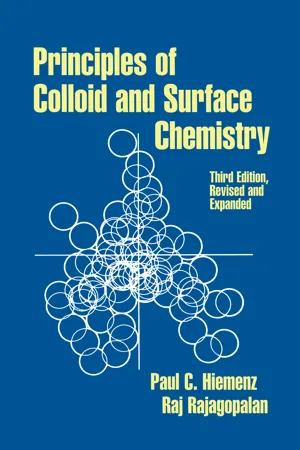Physics
Van der Waals Attraction
Van der Waals attraction refers to the weak intermolecular forces between molecules, arising from temporary fluctuations in electron distribution. These forces include dipole-dipole interactions, induced dipole interactions, and dispersion forces. Van der Waals attraction plays a crucial role in determining the physical properties of substances, such as their boiling and melting points, and is important in understanding the behavior of gases and liquids.
Written by Perlego with AI-assistance
Related key terms
Related key terms
1 of 4
Related key terms
1 of 3
10 Key excerpts on "Van der Waals Attraction"
- Mohammad E. Khosroshahi(Author)
- 2017(Publication Date)
- CRC Press(Publisher)
According to Heisenberg's uncertainty principle (ΔxΔ p ≥ h), which arises from wave-particle duality, it is impossible to measure simultaneously both the position and momentum of a particle within certain limits. It can also be shown that it is similarly impossible to measure the total energy and lifetime of a particle (ΔEΔT ≥ h) simultaneously and with limitless accuracy. Although, the seemingly totally accurate and certain theories of classical physics have been replaced by the probability arguments and uncertainties of the quantum theory, it turns out that concepts such as Heisenberg's uncertainty principle predict new, hitherto unexpected phenomena. Finally, electrons play a major role in determining the properties of the various elements. At the turn of the century, physicists spent much effort in trying to derive all the observed phenomena related to the elements from a mathematical model of the atom. One key phenomenon was the production of spectral lines by atoms on being heated: each element has its own unique atomic spectrum. In trying to explain the generation and appearance of atomic spectra, physicists found that they had to introduce one of the basic concepts of modern physics: the quantum.4.2 Mesoscopic forcesThe fundamental forces that drive the interactions between the various forms of matter are electrostatics, gravity and magnetism. However, there are other subtle natural forces that in combination with geometric and dynamic effects determine the interactions of biological molecules. These include: cohesive forces (van der Waals), hydrogen bonding, electrostatics, steric forces, fluctuation forces, depletion forces and hydrodynamic interactions.4.2.1 van der Waals forces (Cohesive forces)As it was seen in Fig. 4.1 , the van der Waals forces include attraction and repulsion between atoms, molecules, and surfaces, as well as other intermolecular forces (Pauli exclusion principle, electrostatic interaction, polarization and London dispersion). They are different from covalent and ionic bonding in that they are caused by correlations in the fluctuating polarizations of the nearby particles. In the limit of close-approach, the spheres are sufficiently large as compared to the distance between them; i.e., r << R1 or R2 . The van der Waals force (Fw ) between two spheres of constant radii R1 and R2 is given by,(4.14)F w= -AR 1R 2(6R 1+R 2)r 2It is seen from the Eq. (4.14 ), that the van der Waals force decreases with the decreasing size of bodies (R) and the increasing intermolecular distance (r). Consequently, the van der Waals forces become dominant for collections of very small particles such as very fine-grained dry powders even though the force of attraction is smaller in magnitude than it is for larger particles of the same substance. It is well-known that van der Waals interaction is the most dominant cohesion force between matter with a relatively weak bond strength of about 1 kJmol–1 . The origin of this force is an attractive force that acts between two molecules due to the interaction between two dipoles. The potential V12- William M R Simpson, Ulf Leonhardt(Authors)
- 2015(Publication Date)
- WSPC(Publisher)
1 ]. The question is then, what is the origin of the long-range attractive force suggested by van der Waals?Keesom calculated the interaction potential between two molecules with a permanent dipole moment. At a finite temperature T , the molecules are randomly rotating and there exists a non-vanishing average potential scaling as U ∝ −T /r 6 , where r is the distance between the molecules [2 ]. A similar result may be obtained when the dipole of one molecule is induced by that of the other molecule, whose dipole is in turn induced by thermal fluctuations, rather than being permanent. Namely, classical physics considerations showed that an attractive 1/r 6 potential may exist between any pair of particles, so long as they are polarisable – in other words, that their dipoles can be induced by an electric field. The potential is driven by thermal fluctuations, and hence grows linearly with T . This result, whilst providing a physical mechanism for an attractive force between a large class of neutral particles, was nevertheless inconsistent with experimental evidence, which showed that at very low temperatures the force seemed to diminish very slowly with temperature and even reach a constant value, rather than decreasing linearly with temperature T [2 , 3 ].This calls quantum physics into play, and in 1930 London [2 ] used lowest order quantum mechanical perturbation theory, combined with electrostatic considerations, to obtain an attraction varying as 1/r 6 between polarisable molecules at zero temperature. London interpreted this interaction, now widely known as the dispersion force, as originating from the zero-point motion of the molecular degrees of freedom, which is a strictly quantum mechanical effect. London’s remarkable result did not end the story however, since experimental results in the late 1940s led to a suggestion made by Overbeek, that at long distances r the intermolecular potential decreases more rapidly with r than the 1/r 6 scaling, possibly due to retardation [4 ]. Indeed, using an analysis based on quantum electrodynamics, Casimir and Polder (1948) [4 ] were able to obtain an interaction potential at zero temperature that falls off as 1/r 7- eBook - ePub
- Jacob N. Israelachvili(Author)
- 2010(Publication Date)
- Academic Press(Publisher)
6 Van der Waals Forces6.1 Origin of the Van der Waals-dispersion Force between Neutral Molecules: the London Equation
The various types of physical forces described so far are fairly easy to understand, since they arise from straightforward electrostatic interactions involving charged or dipolar molecules. But there is a another type of force that like the gravitational force—acts between all atoms and molecules, even totally neutral ones such as helium, carbon dioxide, and hydrocarbons. These forces have been variously known as dispersion forces, London forces, charge-fluctuation forces, electrodynamic forces, and induced-dipole-induced-dipole forces. We shall refer to them as dispersion forces, since it is by this name that they are most widely known. The origin of this name has to do with their relation to the dispersion of light in the visible and UV regions of the spectrum, as we shall see. The literature on this subject is quite voluminous, and the reader is referred to books and reviews by1 London (1937), Hirschfelder et al., (1954), Moelwyn-Hughes (1961), Margenau and Kestner (1971), Israelachvili (1974), Mahanty and Ninham (1976), and Parsegian (2006).Dispersion forces make up the third and perhaps most important contribution to the total van der Waals force between atoms and molecules, and because they are always present (in contrast to the other types of forces that may or may not be present, depending on the properties of the molecules), they play a role in a host of important phenomena such as adhesion; surface tension; physical adsorption; wetting; the properties of gases, liquids, and thin films; the strengths of solids; the flocculation of particles in liquids; and the structures of condensed macromolecules such as proteins and polymers. Their main features may be summarized as follows: - Paul C. Hiemenz, Raj Rajagopalan, Paul C. Hiemenz, Raj Rajagopalan(Authors)
- 2016(Publication Date)
- CRC Press(Publisher)
■ * * *In this section we have examined the three major contributions to what is generally called the Van der Waals Attraction between molecules. All three originate in dipole-dipole interactions of one sort or another. There are two consequences of this: (a) all show the same functional dependence on the intermolecular separation, and (b) all depend on the same family of molecular parameters, especially dipole moment and polarizability, which are fairly readily available for many simple substances. Many of the materials we encounter in colloid science are not simple, however. Hence we must be on the lookout for other measurable quantities that depend on van der Waals interactions. Example 10.2 introduces one such possibility. We see in Section 10.7 that some other difficulties arise with condensed systems that do not apply to gases.In the next section we take a preliminary look at the way Van der Waals Attractions scale up for macroscopic (i.e., colloidal) bodies. This will leave us in a better position to look for other measurements from which to estimate the van der Waals parameters.10.5 VAN DER WAALS FORCES BETWEEN LARGE PARTICLES AND OVER LARGE DISTANCESThe interaction between individual molecules obviously plays an important role in determining, for example, the nonideality of gas, as illustrated in Example 10.2 . It is less clear how to apply this insight to dispersed particles in the colloidal size range. If atomic interactions are assumed to be additive, however, then the extension to macroscopic particles is not particularly difficult. Moreover, when dealing with objects larger than atomic dimensions, we also have to consider interactions over appropriately large distances. In the case of the London attraction, forces over large distances show a more rapid decay than indicated by the inverse sixth-power equations derived in Section 10.4 . This is known as (electromagnetic) retardation. We discuss these two important issues in this section before developing the equations for interactions between macroscopic bodies in Section 10.6- eBook - ePub
Fundamentals of Atomic Force Microscopy
Part I: Foundations
- Ronald Reifenberger(Author)
- 2015(Publication Date)
- WSPC(Publisher)
Chapter 4
Van der Waals Interactions between Macroscopic Objects
The van der Waals (vdWs) interactions between individual atoms discussed in the previous chapter have three distinct origins: dipole–dipole, dipole– induced dipole, and induced dipole–induced dipole. Two important features come from a careful study of these interactions: their short range and the small net attractive force that can develop between atoms. In 1937, Hamaker developed a theory for vdW interactions between macroscopic bodies and showed that if pair-wise additivity of inter-molecular vdW forces is assumed, the vdW interaction can lead to long-range forces with sufficient strength to make them directly observable in a laboratory setting [hamaker37]. In 1959, a more fundamental theory was developed by Dzyaloshinskii, Lifshitz and Pitaevskii, which circumvented the pair-wise additive assumption [dzyaloshinskii61].In the following chapter we review these various theories and use them to derive equations describing the interaction of a tip with a flat substrate, a geometry of considerable interest to AFM applications.To use an AFM intelligently, you must be aware of the models that describe the force between a tip and substrate and you must understand what features of these models you can control experimentally. The predictions of these models are routinely used to quantitatively understand AFM data. In general terms, these topics are usually of most interest to students of mechanical engineering and physics.4.1 Integrating the van der Waals InteractionIn Chapter 3 , we discussed the vdW interaction potential energy between two atoms that are separated by a distance z in a medium held at temperature T having a dielectric constant κ. If the atoms have dipole moments p1 , p2 , polarizabilities α1 , α2 and ionization energies I1 and I2 - eBook - ePub
- K. L. Mittal, K. L. Mittal(Authors)
- 2019(Publication Date)
- Wiley-Scrivener(Publisher)
The prediction and control of the behavior of microsystems in different real circumstances while under usage cannot be accomplished with success and accuracy if the processes underlying this behavior are not properly studied and modeled. Many forces are known to cause adhesion and cohesion between macroscopic objects, one of them is the capillary force which manifests due to the presence of a liquid medium between the interacting objects [2]; also the presence of a charge gives rise to the electrostatic force [2–4], and at last dispersion forces that exist in all cases regardless of the type of matter or medium [5, 6], The effect of these forces can lead to sticking of the mechanical elements in nano-/micro-electromechanical systems (NEMS/MEMS)[7–10]. Due to their critical effect, the study of dispersion forces is very significant and crucial for predicting and controlling the behavior of such small systems [8, 9].In this review we will focus only on the van der Waals (vdW) forces. The aim of this review is to present an adequate summary of the basic concepts and the different modeling approaches used to study this phenomenon. This review will also focus on updating the knowledge of the reader on the latest works presented by researchers to predict and understand dispersion adhesion forces.9.2 Basic Concepts
London [11] was the first to present a quantum mechanical description of these forces, finding the dispersion energy to be proportional to the distance by r–6 .(1)Where α1,2 are the polarizabilities of the atoms, ω0 is the characteristic frequency, h is given by h/2π with h is Planck’s constant and r is the distance between the center points of the interacting atoms.However, this description was incomplete, since London had disregarded the finite speed of photons transferred between interacting atoms, and he thus considered an instantaneous interaction (Figure 1 ). To overcome this limitation, Casimir and Polder [12] introduced a model which accounted for the finite speed of electromagnetic waves (Figure 1 ), and they found that when the distance is sufficiently large, the energy starts to decay faster and becomes proportional to r–7 .Key manifestations of the dispersion forces, with the first approximation given by London describing an instantaneous dipole generating a field which induces a dipole simultaneously without any retardation (a). The effect of retardation is considered by introducing the finite speed of light into the interaction (b). When macroscopic objects are involved, dispersion forces rise in the form of a Casimir pressure (cFigure 9.1 - eBook - ePub
Particles in Water
Properties and Processes
- John Gregory(Author)
- 2005(Publication Date)
- CRC Press(Publisher)
Even when the atoms or molecules are nonpolar, the movement of electrons around nuclei give “fluctuating dipoles,” which induce dipoles in other molecules and hence an attraction. From the standpoint of colloid stability this is the most important of the intermolecular interactions. It is a quantum-mechanical effect, first recognized by Fritz London in 1930. For this reason the resulting forces are sometimes known as London-van der Waals forces. However they are also known as dispersion forces because the fundamental electron oscillations involved are also responsible for the dispersion of light. (This term may be a source of some confusion—it does not refer to dispersions of particles.) All of these interactions show the same distance dependence—the energy of attraction between molecules varies inversely as the sixth power of separation distance, r: (4.4) where B is a constant that depends on the properties of the interacting molecules (often known as the London constant) and the negative sign indicates an attraction. 1/r 6 The dependence on 1/r 6 shows that the interaction falls off rapidly with increasing distance. However, between macroscopic objects, the attraction is of longer range and plays a vital part in the interaction of colloidal particles. 4.2.2 Interaction between macroscopic objects All objects are assemblies of atoms and molecules, subject to the intermolecular interactions just discussed. In principle, the total interaction between two objects, of known geometric form, can be derived by adding up all of the individual intermolecular attractions. The summation is replaced by integration over the volumes of the interacting objects, and the result depends on the number of molecules per unit volume and the appropriate London constant, B. Such an approach was adopted by H.C. Hamaker in the 1930s; he showed that the resulting interactions could be appreciable at large separations - eBook - ePub
- Richard M. Pashley, Marilyn E. Karaman(Authors)
- 2021(Publication Date)
- Wiley(Publisher)
9 Van Der Waals Forces and Colloid StabilityHistorical development of van der Waals forces. The Lennard‐Jones potential. Intermolecular forces. Van der Waals forces between surfaces and colloids. The Hamaker constant. The DLVO theory of colloidal stability.HISTORICAL DEVELOPMENT OF VAN DER WAALS FORCES AND THE LENNARD‐JONES POTENTIAL
In 1873 van der Waals pointed out that real gases do not obey the ideal gas equation PV = RT and suggested that two ‘correction’ terms should be included to give a more accurate representation, of the form (P + a/v2)(V − b) = RT. The term a/v2corrects for the fact that there will be an attractive force between all gas molecules (both polar and non‐polar) and hence the observed pressure must be increased to that of an ideal, non‐interacting gas. The second term (b) corrects for the fact that the molecules are finite in size and act like hard spheres on collision; the actual free volume must then be less than the total measured volume of the gas. These correction terms are clearly to do with the interaction energy between molecules in the gas phase.In 1903 Mie proposed a general equation to account for the interaction energy (V) between molecules:(9.1)of which the most usual and mathematically convenient form is the Lennard‐Jones 6‐12 potential:(9.2)where the first term represents the attraction and the second the repulsion between two molecules separated by distance d. This equation quite successfully describes the interaction between non‐polar molecules, where the attraction is due to so‐called dispersion forces, and the very short‐range second term is the Born repulsion, caused by the overlap of molecular orbitals.From our observation of real gases, it is clear that attractive dispersion forces exist between all neutral, non‐polar molecules. These forces are also referred to as London forces after the explanation given by him in about 1930. At any given instant, a neutral molecule will have a dipole moment because of fluctuations in the electron distribution in the molecule. This dipole will create an electric field which will polarize a nearby neutral molecule, inducing a correlated dipole moment. The interaction between these dipoles leads to an attractive energy of the form V = −C/d6. The time‐averaged dipole moment of each molecule is, of course, zero, but the time‐averaged interaction energy is finite, because of this correlation between interacting temporary diploes. It is mainly this force which holds molecular solids and liquids, such as hydrocarbons and liquefied gases, together. The L‐J interaction potential V - eBook - ePub
- Erle C. Donaldson, Waqi Alam(Authors)
- 2013(Publication Date)
- Gulf Publishing Company(Publisher)
CHAPTER 2Surface Forces
2.1 Introduction2.2 Van der Waals Equation of State2.3 Electrostatic Interactive Energies2.4 Dielectric Media2.5 Principle Interactive Forces2.5.1 Short-Range Forces2.5.2 London Dispersion Forces2.6 Dipole Forces2.6.1 Keesom Dipole-Dipole Forces2.6.2 Debye-Induced Dipole Interactions2.6.3 Van der Waals Forces2.7 Zeta Potential and the Electric Double Layer Interaction2.8 DLVO (Derjaguin, Landau, Verwey, and Overbeek) Theory2.9 Hamaker Constant2.10 Disjoining Pressure2.10.1 Electrostatic Forces2.10.2 Poisson-Boltzman Equation2.10.3 Counterion Density with Respect to Distance (Diffuse Double Layer)2.10.4 Osmotic Repulsion Pressure2.10.5 Hydration Forces2.10.6 Disjoining Pressure and the Canonical Potential2.11 Hydrogen Bonding2.12 Summary of Interactive Forces2.13 Lewis Acid/Base Reactions2.14 Solvent Behavior2.15 Solid Surface Interactions with Solutions2.15.1 Clay Swelling and Particle Movement2.15.2 Crude Oil/Solid Surface Interactions2.16 Example Problems2.1 Introduction
Surface forces are the basis for the various states of wettability and are the intermolecular forces that control the attraction, repulsion and adhesion of condensed states of matter. The subject is very broad when it is viewed as the global interactions of all molecules and is beyond the scope of this single chapter. Therefore, the topic that encompasses the interactions of molecules is confined to the preferential adhesion of water and hydrocarbons on surfaces of geological materials: specifically, the preferential wetting of water and oil on rock surfaces.When the pressure, molar volume, and temperature of a gas or mixture of gases exceed a critical value, the gaseous molecules have been compressed to distances where attractive forces dominate, causing the gas to condense to a liquid. The gas is easily compressed; however, the compressibility of the liquid is relatively minute because further compression is opposed by strong repulsive forces as the molecules are brought closer together. It is thus apparent that the molecular interaction is a function of the distance of separation of the molecules. - eBook - ePub
- J. S. Rowlinson, B. Widom(Authors)
- 2013(Publication Date)
- Dover Publications(Publisher)
3 THE THEORY OF VAN DER WAALS3.1 Introduction‘I am more than ever an admirer of van der Waals’; so wrote Lord Rayleigh1 in a private letter in 1891. It was a view shared by many of the best nineteenth-century physicists and chemists. Twenty years earlier Maxwell had taught himself Dutch in order to be able to read van der Waals’s thesis, while Ostwald translated his work for republication in German. What commanded the admiration of such men was his development of powerful and far-sighted methods of approximation in the newly developing subject of statistical thermodynamics. We have already touched in Chapter 1 on his contribution to the development of the mean-field approximation; here we describe his application of these ideas to the state of matter within the gas-liquid surface.In the quasi-thermodynamics of the last chapter we introduced a local free-energy density ψ(z), although its identification in (2.90 ) proved unsatisfactory; it led to a vanishing interfacial tension σ and to a density profile ρ(z) that was a step-function. What is missing in (2.90 ) is a term that imposes a characteristic length on the fluid, and thus leads, after minimization of the integrated excess free-energy density, to a density profile consistent with an interface of non-zero thickness. The theory was given such a form by van der Waals;2 Landau and Lifshitz’s theory of magnetic domain structure3 is equivalent, and the theory has been reformulated and extended by Cahn and Hilliard.4 In this chapter we present van der Waals’s theory and some of its elaborations.Let ψ(z) continue to represent the local free-energy density of (initially) a one-component system, though now not necessarily given by (2.90 ). Whatever the correct ψ(z), let Ψ(z
Index pages curate the most relevant extracts from our library of academic textbooks. They’ve been created using an in-house natural language model (NLM), each adding context and meaning to key research topics.
Explore more topic indexes
Explore more topic indexes
1 of 6
Explore more topic indexes
1 of 4









